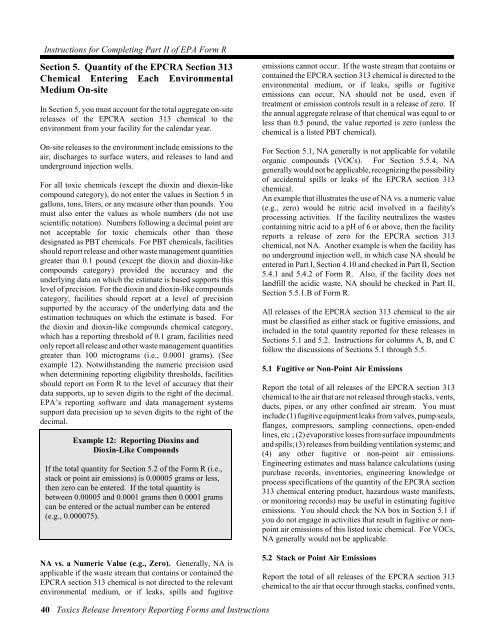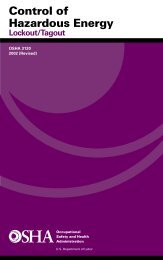Toxic Chemical Release Inventory Reporting Forms and Instructions
Toxic Chemical Release Inventory Reporting Forms and Instructions
Toxic Chemical Release Inventory Reporting Forms and Instructions
You also want an ePaper? Increase the reach of your titles
YUMPU automatically turns print PDFs into web optimized ePapers that Google loves.
<strong>Instructions</strong> for Completing Part II of EPA Form R<br />
Section 5. Quantity of the EPCRA Section 313<br />
<strong>Chemical</strong> Entering Each Environmental<br />
Medium On-site<br />
In Section 5, you must account for the total aggregate on-site<br />
releases of the EPCRA section 313 chemical to the<br />
environment from your facility for the calendar year.<br />
On-site releases to the environment include emissions to the<br />
air, discharges to surface waters, <strong>and</strong> releases to l<strong>and</strong> <strong>and</strong><br />
underground injection wells.<br />
For all toxic chemicals (except the dioxin <strong>and</strong> dioxin-like<br />
compound category), do not enter the values in Section 5 in<br />
gallons, tons, liters, or any measure other than pounds. You<br />
must also enter the values as whole numbers (do not use<br />
scientific notation). Numbers following a decimal point are<br />
not acceptable for toxic chemicals other than those<br />
designated as PBT chemicals. For PBT chemicals, facilities<br />
should report release <strong>and</strong> other waste management quantities<br />
greater than 0.1 pound (except the dioxin <strong>and</strong> dioxin-like<br />
compounds category) provided the accuracy <strong>and</strong> the<br />
underlying data on which the estimate is based supports this<br />
level of precision. For the dioxin <strong>and</strong> dioxin-like compounds<br />
category, facilities should report at a level of precision<br />
supported by the accuracy of the underlying data <strong>and</strong> the<br />
estimation techniques on which the estimate is based. For<br />
the dioxin <strong>and</strong> dioxin-like compounds chemical category,<br />
which has a reporting threshold of 0.1 gram, facilities need<br />
only report all release <strong>and</strong> other waste management quantities<br />
greater than 100 micrograms (i.e., 0.0001 grams). (See<br />
example 12). Notwithst<strong>and</strong>ing the numeric precision used<br />
when determining reporting eligibility thresholds, facilities<br />
should report on Form R to the level of accuracy that their<br />
data supports, up to seven digits to the right of the decimal.<br />
EPA’s reporting software <strong>and</strong> data management systems<br />
support data precision up to seven digits to the right of the<br />
decimal.<br />
Example 12: <strong>Reporting</strong> Dioxins <strong>and</strong><br />
Dioxin-Like Compounds<br />
If the total quantity for Section 5.2 of the Form R (i.e.,<br />
stack or point air emissions) is 0.00005 grams or less,<br />
then zero can be entered. If the total quantity is<br />
between 0.00005 <strong>and</strong> 0.0001 grams then 0.0001 grams<br />
can be entered or the actual number can be entered<br />
(e.g., 0.000075).<br />
NA vs. a Numeric Value (e.g., Zero). Generally, NA is<br />
applicable if the waste stream that contains or contained the<br />
EPCRA section 313 chemical is not directed to the relevant<br />
environmental medium, or if leaks, spills <strong>and</strong> fugitive<br />
emissions cannot occur. If the waste stream that contains or<br />
contained the EPCRA section 313 chemical is directed to the<br />
environmental medium, or if leaks, spills or fugitive<br />
emissions can occur, NA should not be used, even if<br />
treatment or emission controls result in a release of zero. If<br />
the annual aggregate release of that chemical was equal to or<br />
less than 0.5 pound, the value reported is zero (unless the<br />
chemical is a listed PBT chemical).<br />
For Section 5.1, NA generally is not applicable for volatile<br />
organic compounds (VOCs). For Section 5.5.4, NA<br />
generally would not be applicable, recognizing the possibility<br />
of accidental spills or leaks of the EPCRA section 313<br />
chemical.<br />
An example that illustrates the use of NA vs. a numeric value<br />
(e.g., zero) would be nitric acid involved in a facility's<br />
processing activities. If the facility neutralizes the wastes<br />
containing nitric acid to a pH of 6 or above, then the facility<br />
reports a release of zero for the EPCRA section 313<br />
chemical, not NA. Another example is when the facility has<br />
no underground injection well, in which case NA should be<br />
entered in Part I, Section 4.10 <strong>and</strong> checked in Part II, Section<br />
5.4.1 <strong>and</strong> 5.4.2 of Form R. Also, if the facility does not<br />
l<strong>and</strong>fill the acidic waste, NA should be checked in Part II,<br />
Section 5.5.1.B of Form R.<br />
All releases of the EPCRA section 313 chemical to the air<br />
must be classified as either stack or fugitive emissions, <strong>and</strong><br />
included in the total quantity reported for these releases in<br />
Sections 5.1 <strong>and</strong> 5.2. <strong>Instructions</strong> for columns A, B, <strong>and</strong> C<br />
follow the discussions of Sections 5.1 through 5.5.<br />
5.1 Fugitive or Non-Point Air Emissions<br />
Report the total of all releases of the EPCRA section 313<br />
chemical to the air that are not released through stacks, vents,<br />
ducts, pipes, or any other confined air stream. You must<br />
include (1) fugitive equipment leaks from valves, pump seals,<br />
flanges, compressors, sampling connections, open-ended<br />
lines, etc.; (2) evaporative losses from surface impoundments<br />
<strong>and</strong> spills; (3) releases from building ventilation systems; <strong>and</strong><br />
(4) any other fugitive or non-point air emissions.<br />
Engineering estimates <strong>and</strong> mass balance calculations (using<br />
purchase records, inventories, engineering knowledge or<br />
process specifications of the quantity of the EPCRA section<br />
313 chemical entering product, hazardous waste manifests,<br />
or monitoring records) may be useful in estimating fugitive<br />
emissions. You should check the NA box in Section 5.1 if<br />
you do not engage in activities that result in fugitive or nonpoint<br />
air emissions of this listed toxic chemical. For VOCs,<br />
NA generally would not be applicable.<br />
5.2 Stack or Point Air Emissions<br />
Report the total of all releases of the EPCRA section 313<br />
chemical to the air that occur through stacks, confined vents,<br />
40 <strong>Toxic</strong>s <strong>Release</strong> <strong>Inventory</strong> <strong>Reporting</strong> <strong>Forms</strong> <strong>and</strong> <strong>Instructions</strong>
















